Table of Contents
- Introduction
- Editor’s Choice
- Global 5G Fixed Wireless Access Market Overview
- Fixed wireless access (FWA) Connections Statistics
- Mobile 5G Subscriptions Statistics
- 5G Fixed Wireless Access Consumer Usage Pattern Statistics
- Cost Considerations in 5G Fixed Wireless Access
- Challenges in 5G Fixed Wireless Access
- Opportunities in 5G Fixed Wireless Access Regards to Spectrum
- Recent Developments
- Conclusion
- FAQs
Introduction
5G Fixed Wireless Access Statistics: 5G Fixed Wireless Access (FWA) represents a groundbreaking wireless technology that delivers high-speed internet connectivity through 5G networks, eliminating the necessity for physical cables.
It provides exceptionally fast speeds and minimal delays, serving a wide range of locations, including cities, suburbs, rural areas, and underserved regions, benefiting both homes and businesses.
FWA also supports Internet of Things (IoT) applications and contributes to the expansion of digital services, playing a crucial role in today’s digital landscape.
Moreover, with many service providers actively rolling out 5G FWA networks, it ensures improved connectivity and competitive choices in the broadband market while addressing the challenges associated with last-mile connectivity.
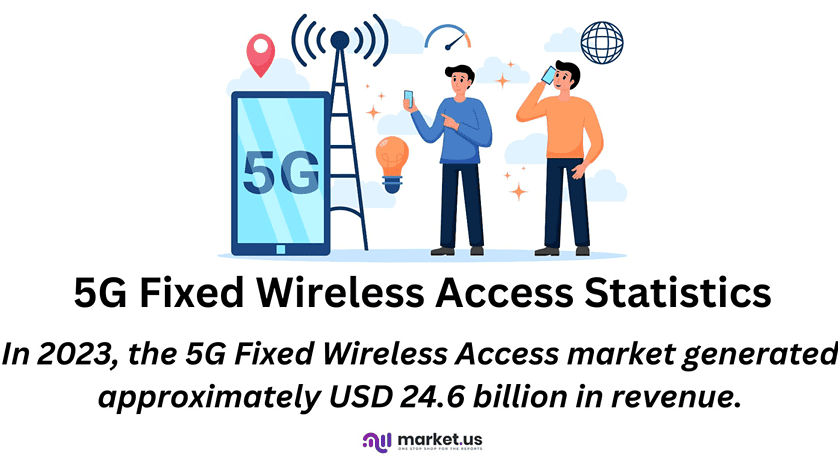
Editor’s Choice
- In 2022, the 5G Fixed Wireless Access market generated approximately USD 17.8 billion in revenue.
- As we moved into 2023, the market continued its ascent, reaching USD 24.6 billion in total revenue, with hardware and services generating USD 15.2 billion and USD 9.3 billion, respectively.
- In the application landscape, residential use holds the largest share, comprising 38% of the market.
- In 2020, there were 4.26 million FWA connections utilizing 5G technology and a significantly larger 68.18 million connections through 4G and other technologies.
- Cisco’s Annual Internet Report predicts that by 2021, video traffic over IP networks will constitute 82% of all consumer internet traffic, compared to 73% in 2016.
- Broadening the coverage of low band carriers beyond LTE’s 20 MHz carrier, utilizing higher numerology when feasible, and increasing PRB capacity, has the potential to bring reasonably effective service to the most remote and underserved regions using a limited number of sites.
- The mid-band, consisting of 2 GHz (B2/25 and B66A), 2.5 GHz (B41), and 3.5 GHz (B48, n77D, and future NTIA spectrum), is often viewed as an efficient choice by some analysts. It allows carriers to operate within a TDD spectrum range spanning from 5 MHz to 100 MHz.
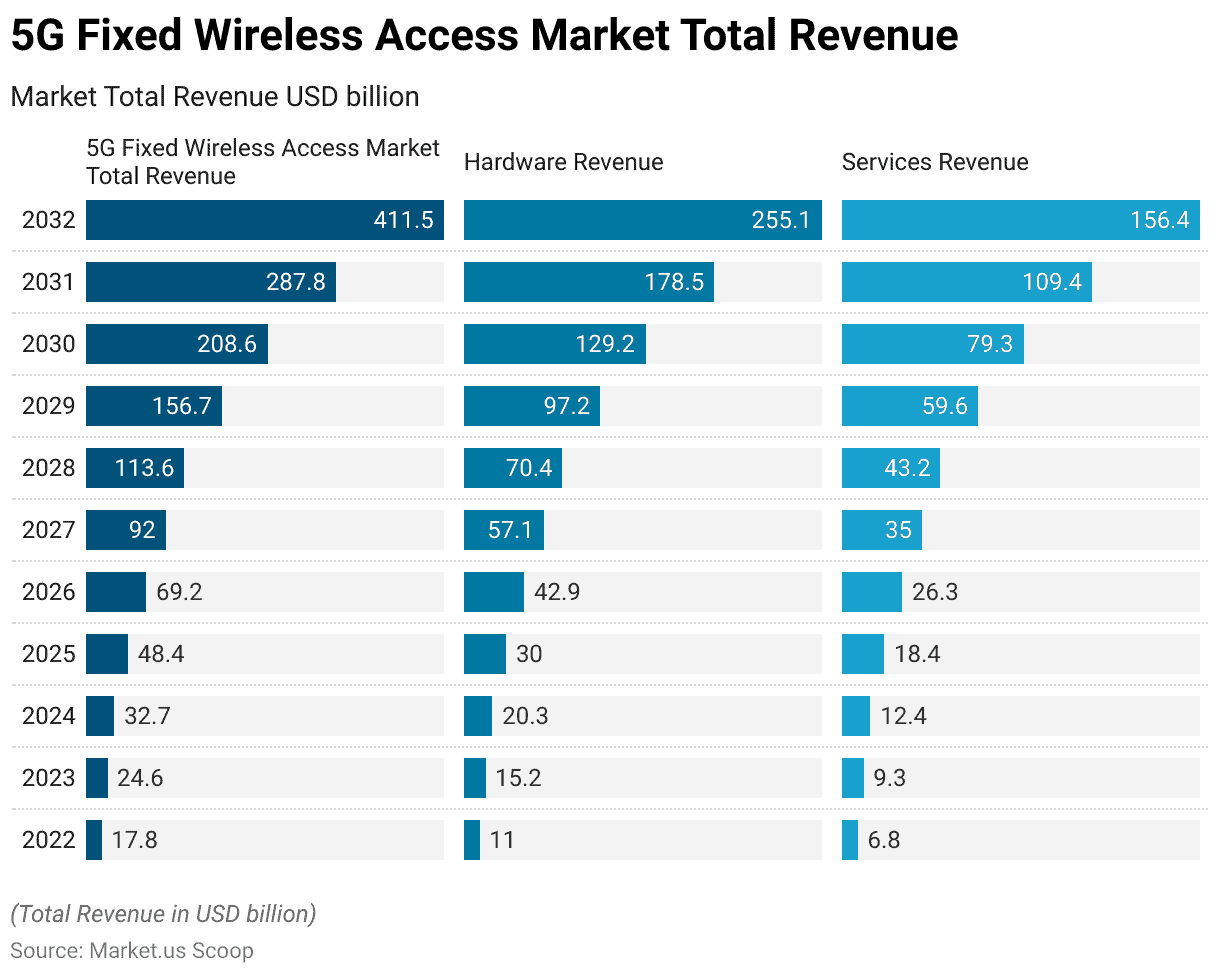
Global 5G Fixed Wireless Access Market Overview
Global 5G Fixed Wireless Access Market Size Statistics
- The revenue of the 5G Fixed Wireless Access market has displayed a significant upward trajectory over the years at a CAGR of 38%., with consistent growth projected for the foreseeable future.
- In 2022, the market generated approximately USD 17.8 billion in revenue.
- This figure experienced a notable increase, reaching USD 24.6 billion in 2023.
- The momentum continued to build as the market revenue surged to USD 32.7 billion in 2024 and reached even more impressive heights at USD 48.4 billion in 2025.
- The subsequent years continued to witness remarkable growth, with projections indicating revenues of USD 69.2 billion in 2026, USD 92.0 billion in 2027, and USD 113.6 billion in 2028.
- As we look further ahead, the market is poised to exceed expectations, with projected revenues of USD 156.7 billion in 2029, USD 208.6 billion in 2030, USD 287.8 billion in 2031, and an impressive USD 411.5 billion in 2032.
- These robust figures highlight the increasing demand and opportunities within the 5G Fixed Wireless Access market, making it an area of substantial interest for investors and industry stakeholders.
(Source: Market.us)
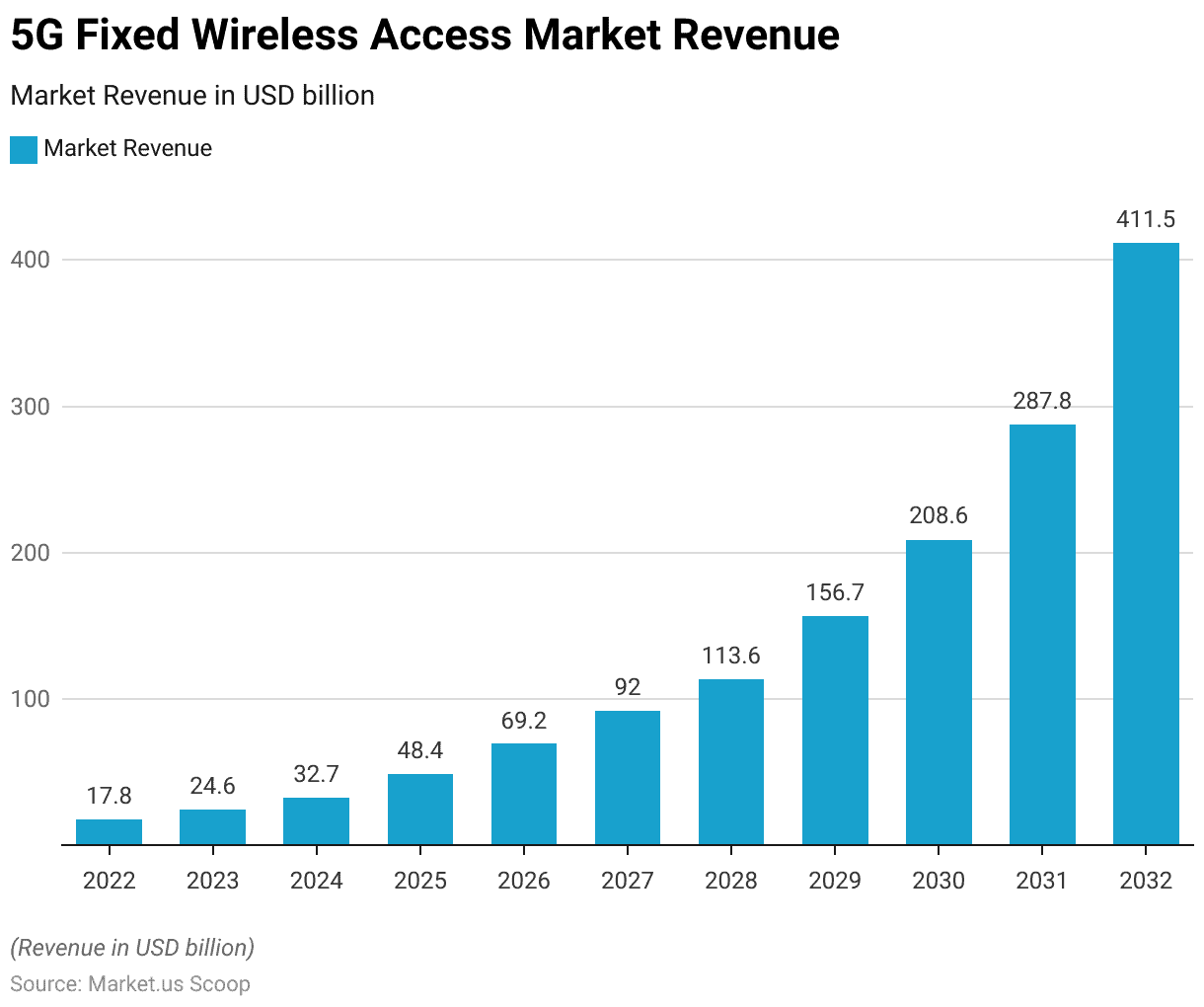
Global 5G Fixed Wireless Access Market Size – By Offering Statistics
- The Global 5G Fixed Wireless Access market has shown remarkable revenue growth, categorized into hardware and services offerings.
- In 2022, the market’s total revenue stood at USD 17.8 billion, with hardware accounting for USD 11.0 billion and services contributing USD 6.8 billion.
- As we moved into 2023, the market continued its ascent, reaching USD 24.6 billion in total revenue, with hardware and services generating USD 15.2 billion and USD 9.3 billion, respectively.
- The trend of substantial growth persisted, resulting in total revenues of USD 32.7 billion in 2024, USD 48.4 billion in 2025, and USD 69.2 billion in 2026, with hardware and services playing significant roles in these figures.
- Looking ahead, the market is projected to maintain its upward trajectory, with revenues expected to reach USD 92.0 billion in 2027, USD 113.6 billion in 2028, and USD 156.7 billion in 2029.
- Hardware and services revenues are also expected to grow substantially in tandem.
- By 2030, the total market revenue is forecasted to reach USD 208.6 billion, with hardware contributing USD 129.2 billion and services adding USD 79.3 billion.
- The growth story continues into 2031 and 2032, with the market expected to achieve revenues of USD 287.8 billion and USD 411.5 billion, respectively, driven by robust contributions from both hardware and services.
- These impressive figures underscore the promising prospects within the Global 5G Fixed Wireless Access market, making it an area of significant interest for investors and industry stakeholders alike.
(Source: Market.us)
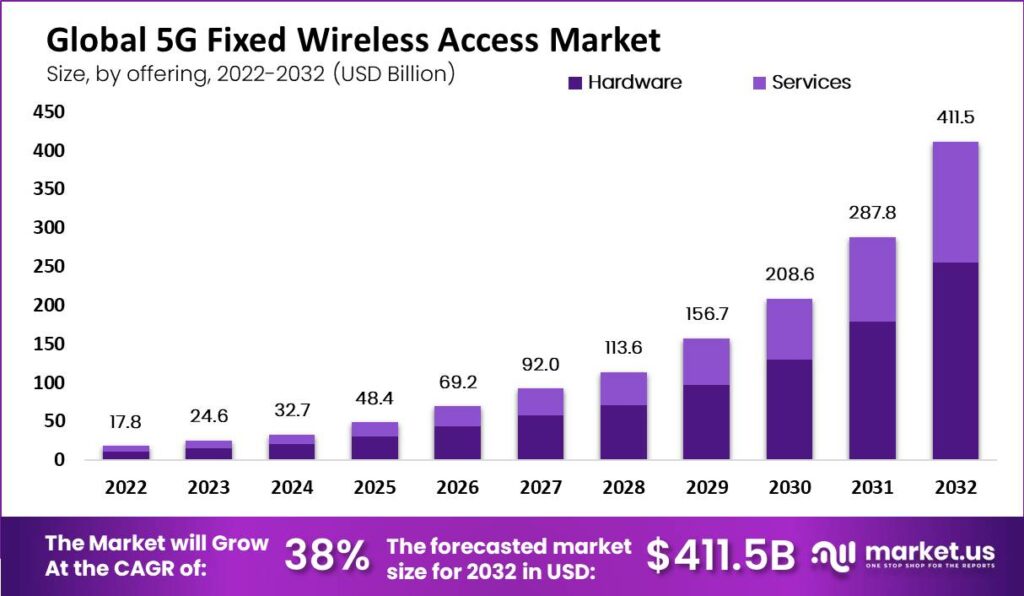
Global 5G Fixed Wireless Access Market Share – By Application Statistics
- The Global 5G Fixed Wireless Access market exhibits a diverse distribution of market share across various applications.
- In this landscape, residential use holds the largest share, comprising 38% of the market.
- Commercial applications follow closely behind, accounting for 27% of the market share. Industrial sectors represent 11% of the market, highlighting their significant but relatively smaller presence.
- Government applications hold a notable 18% share, reflecting their substantial involvement in the 5G Fixed Wireless Access market.
- Additionally, other applications collectively contribute 6% to the market share, indicating a range of niche uses within this evolving industry.
- This distribution underscores the versatility and adaptability of 5G Fixed Wireless Access technology across multiple sectors, making it a pivotal player in modern connectivity solutions.
(Source: Market.us)
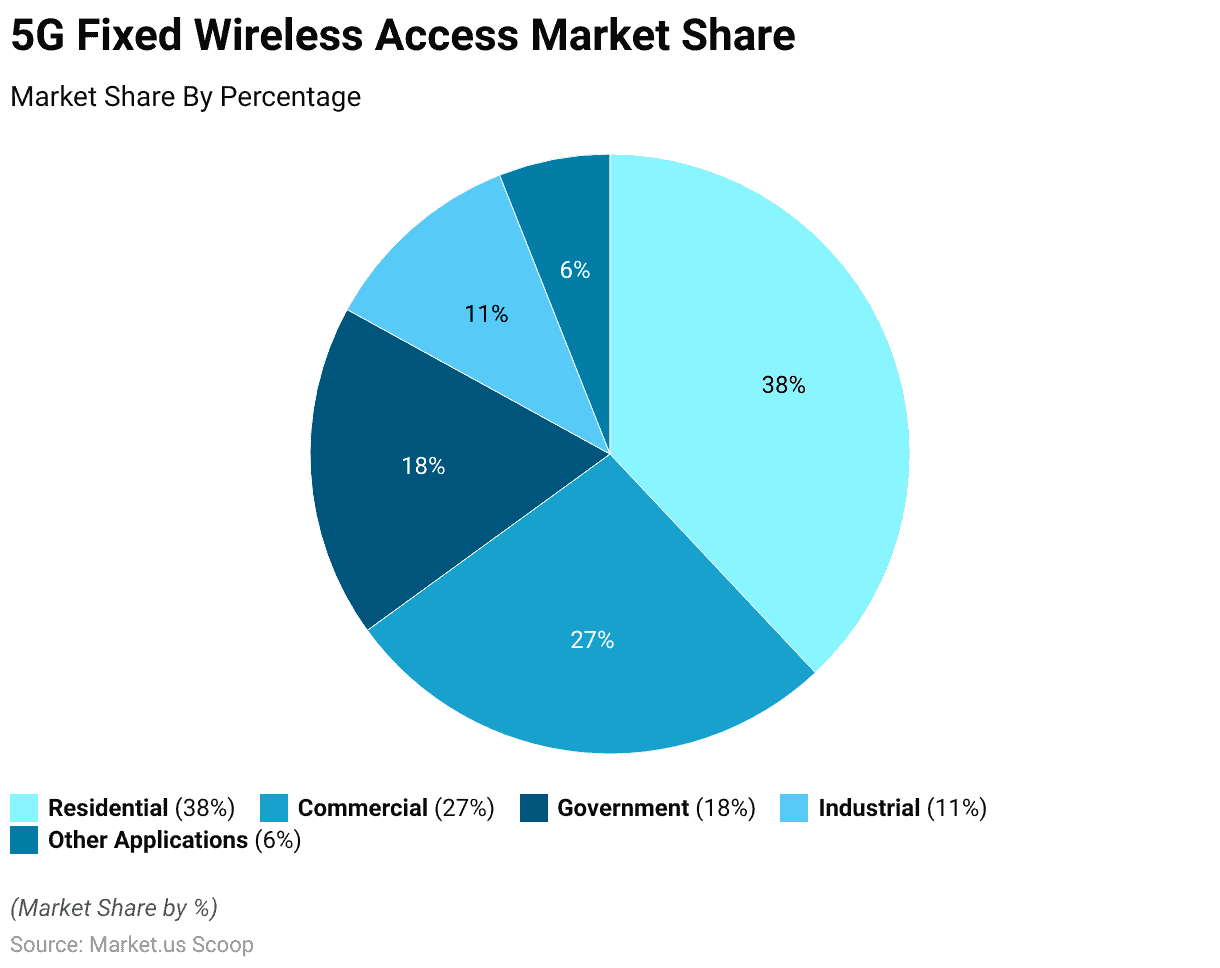
Fixed wireless access (FWA) Connections Statistics
- The global landscape of Fixed Wireless Access (FWA) connections has been evolving rapidly, showcasing a substantial growth trajectory from 2020 to 2028.
- In 2020, there were 4.26 million FWA connections utilizing 5G technology and a significantly larger 68.18 million connections through 4G and other technologies.
- However, in just one year, the FWA landscape witnessed a remarkable boost, with 9.27 million 5G connections and 78.47 million connections from 4G and other technologies in 2021.
- The trend continued its upward trajectory, with 2022 recording 19.31 million FWA connections via 5G and 88.19 million through 4G/other technologies.
- The subsequent years saw even more substantial growth, as in 2023, there were 35.26 million 5G FWA connections and 96.44 million connections from 4G/other technologies.
- By 2024, the numbers surged to 58.86 million for 5G and 102.27 million for 4G/other technologies, solidifying the dominance of 5G in the FWA market.
- As we look ahead, the FWA landscape appears poised for exponential growth. In 2025, 98.55 million FWA connections are projected for 5G, while 96.84 million will rely on 4G/other technologies.
- The year 2026 is expected to witness a significant leap, with 145.16 million 5G connections and 84.45 million 4G/other technology connections.
- The trend continues its ascent, with 191.81 million 5G connections and 73.13 million 4G/other technology connections anticipated for 2027.
- Finally, in 2028, the FWA landscape is projected to reach new heights, with 236.22 million connections using 5G technology and 63.82 million relying on 4G and other technologies.
- These statistics not only reflect the rapid adoption of 5G technology but also underscore the growing importance of FWA as a viable internet connectivity solution worldwide.
(Source: Statista)
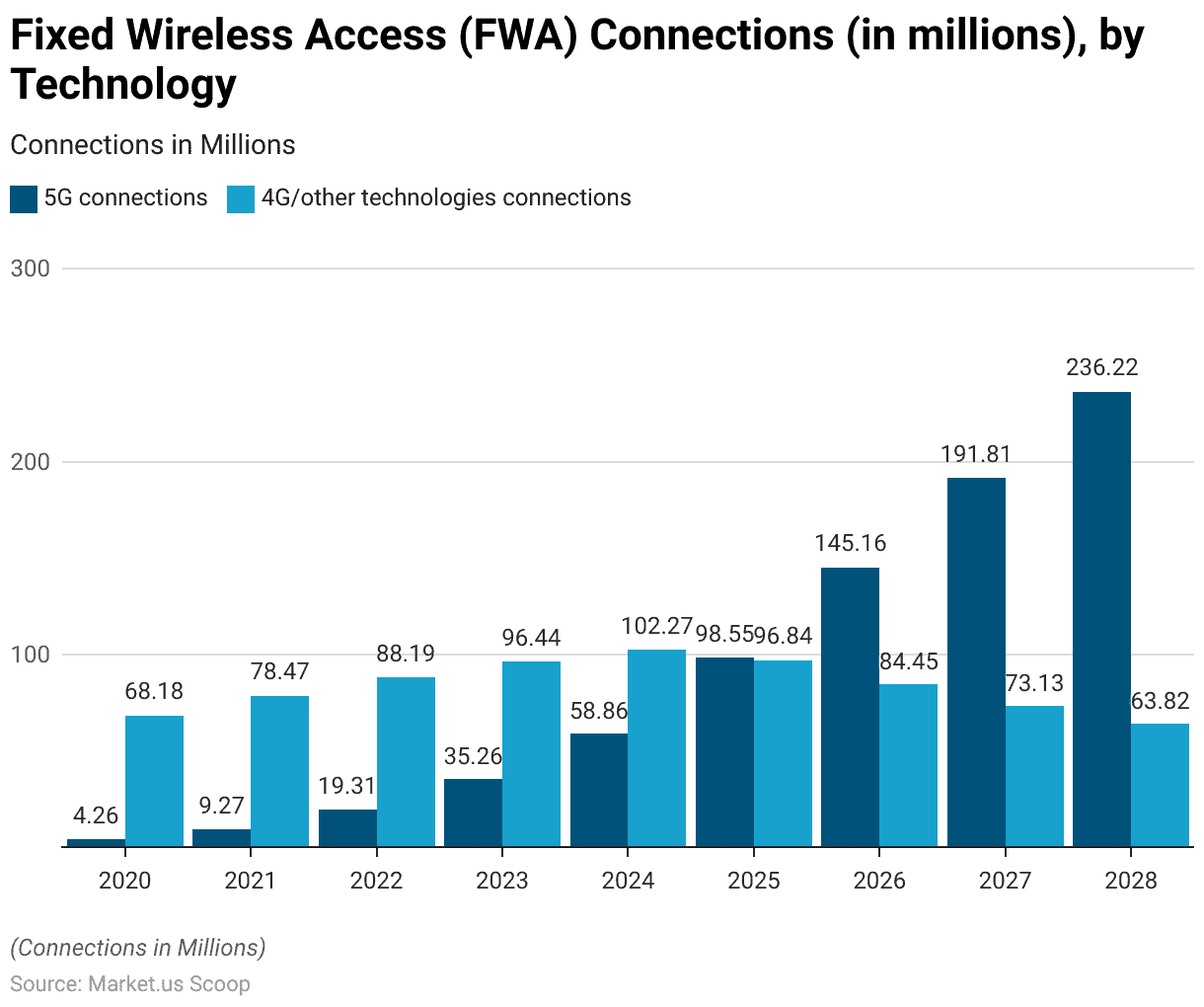
Mobile 5G Subscriptions Statistics
- Further, the global landscape of mobile 5G subscriptions exhibits a remarkable growth pattern from 2019 to the projected figures for 2028, with regional variations reflecting the dynamic nature of the telecommunications industry.
- In 2019, South East Asia & Oceania had 0.11 million 5G subscriptions, while North East Asia led with 9.82 million.
- The following year, 2020, marked a significant leap, particularly in North East Asia, which surged to 134.81 million subscriptions, and North America with 13.97 million.
- As we progress to 2021, the growth continued unabated, with South East Asia & Oceania witnessing a substantial rise to 9.29 million 5G subscriptions, while North East Asia reached an impressive 397.17 million.
- Western Europe and North America also experienced substantial growth, reaching 31.93 million and 54.55 million subscriptions, respectively.
- In 2022, the trend escalated further, with North East Asia leading at 643.07 million, followed by North America at 166.03 million, and Western Europe at 69.07 million.
- The trajectory of mobile 5G subscriptions continued its upward path, with 2023 showing substantial gains in Central & Eastern Europe, reaching 14.39 million, and Middle East & Africa at 58.11 million.
- By 2024, the numbers soared, particularly in North East Asia, with 1101.46 million subscriptions, followed by Western Europe at 233.6 million and North America at 307.25 million.
- The forecast for 2025 and beyond remains highly promising, with all regions experiencing significant growth in 5G subscriptions.
- By 2028, the landscape is projected to reach new heights, with North East Asia at 1615.39 million subscriptions, Western Europe at 491.79 million, and North America at 405.4 million, underlining the global shift towards 5G technology and its increasing prevalence in the telecommunications market worldwide.
(Source: Statista)

5G Fixed Wireless Access Consumer Usage Pattern Statistics
- Common online activities for consumers vary from basic web browsing and email usage to more data-intensive activities like video streaming and gaming, each necessitating a minimum download speed to function effectively.
- Presently, the internet is predominantly used for video-related content. Cisco’s Annual Internet Report predicts that by 2021, video traffic over IP networks will constitute 82% of all consumer internet traffic, compared to 73% in 2016.
- This encompasses data from platforms such as YouTube and BuzzFeed Video, along with popular streaming services like Netflix and Hulu.
- The necessary bit-rate or bandwidth for various well-known applications varies, ranging from basic web browsing and email services like Facebook and Google to the more demanding 4K TV and streaming experiences.
- It’s important to note that Ultra-High-Definition (UHD) video content requires nearly eight times the bandwidth compared to Standard-Definition (SD) video.
- Furthermore, according to CISCO’s projections, the percentage of flat panel TV sets equipped with UHD capability is anticipated to increase to 66% by 2023, a significant rise from the 33% observed in 2018.
- In recent years, the typical household size in the United States has remained relatively consistent, hovering at approximately 2.53 individuals.
- One and two-person households accounted for a substantial 63% of all U.S. households in the year 2020.
- For the majority of residential customers, a broadband service offering download speeds of up to 25 Mbps would sufficiently meet their bandwidth requirements.
(Source: Cisco’s Annual Internet Report)
Cost Considerations in 5G Fixed Wireless Access
- Leveraging the extensive bandwidth of mmWave technology and the enhanced spectral efficiency of 5G can lead to a significant reduction in network costs, measured as cost per bit per hertz.
- This cost reduction can be achieved when the rollout of 5G Fixed Wireless Access (FWA) is meticulously planned to ensure a superior customer experience and the creation of new business opportunities.
- Improved cost efficiency will empower Communication Service Providers (CSPs) to offer Over-the-Top (OTT) services like TV and video streaming to households today, and in the future, it will enable the delivery of Augmented Reality (AR) and Virtual Reality (VR) services.
- This strategic approach not only opens doors to new revenue streams for CSPs but also enhances their profit margins.
(Source: Subex)
Challenges in 5G Fixed Wireless Access
- The days of accepting mediocre product designs are long gone. In today’s digital economy, the younger generation of consumers, including Gen Z and Millennials, have high expectations for products—they want them to be not only visually appealing but also seamless and user-friendly.
- As technology advances, consumers will increasingly seek a unified and easily accessible view of data. This may result in more complex products, which can be addressed in part by adding or developing new features.
- For instance, the 5G network represents a significant leap forward, unlocking the full potential of the Internet of Things (IoT).
- According to GSMA, a wireless industry trade group, 5G’s ultra-reliable and low-latency communication capabilities will connect a staggering 100 times more devices and deliver speeds up to 100 times faster.
- Their research also predicts that by 2025, 5G will account for 15 percent of global mobile connections.
(Source: GSMA)
Opportunities in 5G Fixed Wireless Access Regards to Spectrum
- Broadening the coverage of low band carriers beyond LTE’s 20 MHz carrier, utilizing higher numerology when feasible, and increasing PRB capacity, has the potential to bring reasonably effective service to the most remote and underserved regions using a limited number of sites.
- This approach can also be applied to extend the range of Mid-band Multi-User Massive Input Massive Output (MU-MIMO) deployments in the 2.5 and 3.5 GHz frequency ranges.
- The mid-band, consisting of 2 GHz (B2/25 and B66A), 2.5 GHz (B41), and 3.5 GHz (B48, n77D, and future NTIA spectrum), is often viewed as an efficient choice by some analysts. It allows carriers to operate within a TDD spectrum range spanning from 5 MHz to 100 MHz.
- This range offers high-speed connectivity, low latency, and the advantage of improved indoor coverage due to lower frequencies.
- Moreover, the mid-band spectrum enables Multi-User Massive Input Massive Output (MUMIMO) deployments, enhancing the capacity of a single carrier cell and increasing individual user throughput through beamforming.
- Although mmWave technology doesn’t provide the same coverage or distance as Mid-Band, it offers substantial amounts of spectrum in the 24, 28, 39, and 47 GHz ranges, often hundreds of MHz.
- This wide spectrum allocation enables the provision of multi-gigabit-per-second (Gbps) capacity within a single cell. Additionally, the use of beamforming enhances signal reception for users, resulting in improved broadband performance.
(Source: 5G Americas)
Recent Developments
Acquisitions and Mergers:
- Nokia Acquires Elenion Technologies: In 2023, Nokia completed its acquisition of Elenion Technologies for $200 million. The acquisition strengthens Nokia’s 5G FWA capabilities by integrating Elenion’s photonic chip technology, enabling faster and more reliable wireless broadband services.
- Verizon Acquires BlueJeans for FWA Expansion: In 2023, Verizon acquired BlueJeans, a video conferencing and collaboration platform, for $400 million. This acquisition supports Verizon’s push to expand its 5G FWA services by integrating BlueJeans’ communication technology to optimize network efficiency.
New Product Launches:
- Qualcomm Launches 5G FWA Chipsets: In January 2024, Qualcomm introduced a new generation of 5G FWA chipsets designed to improve bandwidth and connectivity for residential and enterprise users. The chipsets promise a 40% increase in data transfer rates, improving user experience for high-demand applications like video streaming and gaming.
- Samsung Unveils New 5G FWA Solutions: In March 2024, Samsung launched its next-generation 5G FWA solution for global markets, focusing on offering faster download speeds and better coverage. The new solution aims to expand Samsung’s presence in the U.S. and European FWA markets.
Funding:
- Inseego Secures $50 Million for 5G FWA Expansion: In early 2024, Inseego, a leader in wireless broadband solutions, raised $50 million to accelerate its development of 5G FWA devices and infrastructure. The funds will be used to expand the company’s reach in North American and European markets.
- Cambium Networks Raises $25 Million: In December 2023, Cambium Networks secured $25 million in funding to boost its 5G FWA product line. The funding will support the development of next-gen wireless solutions aimed at improving connectivity in underserved areas.
Technological Advancements:
- AI and Edge Computing Integration: By 2025, 35% of 5G FWA networks are expected to incorporate AI and edge computing to optimize network performance and reduce latency, providing faster connections for smart homes and businesses.
- Millimeter-Wave (mmWave) Adoption: The adoption of mmWave technology is increasing in 5G FWA deployments, enabling higher bandwidth and more reliable connections. By 2026, approximately 50% of 5G FWA solutions will use mmWave for enhanced performance, especially in urban areas.
Conclusion
5G Fixed Wireless Access (FWA) is a groundbreaking development in the world of connectivity. It offers high-speed internet access without relying on traditional wired infrastructure, which is a game-changer.
With its advanced capabilities, 5G FWA serves the needs of both households and businesses effectively. Its ability to provide gigabit-level speeds and low latency is a major leap forward in the digital era.
As we see more 5G FWA networks being deployed, it’s set to open up exciting new possibilities and greatly improve the overall broadband experience. This technology is reshaping the telecommunications industry and defining the future of connectivity.
FAQs
5G Fixed Wireless Access (FWA) is a wireless communication technology that provides high-speed internet access to homes and businesses using 5G networks, eliminating the need for traditional wired connections.
5G FWA utilizes 5G radio signals to connect to a fixed receiver or modem at a user’s location, providing fast and reliable internet access.
Key advantages include high-speed connectivity, low latency, flexibility in deployment, and the ability to serve both urban and rural areas.
Use cases include residential internet, business connectivity, bridging the digital divide in underserved areas, and supporting Internet of Things (IoT) devices.
5G FWA can provide gigabit-level speeds and low latency, making it suitable for bandwidth-intensive applications and real-time services.
Discuss your needs with our analyst
Please share your requirements with more details so our analyst can check if they can solve your problem(s)



